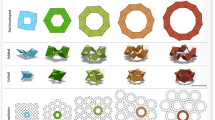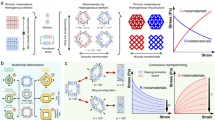Abstract
Origami is used beyond purely aesthetic pursuits to design responsive and customizable mechanical metamaterials1,2,3,4,5,6,7,8. However, a generalized physical understanding of origami remains elusive, owing to the challenge of determining whether local kinematic constraints are globally compatible and to an incomplete understanding of how the folded sheet’s material properties contribute to the overall mechanical response9,10,11,12,13,14. Here, we show that the traditional square twist, whose crease pattern has zero degrees of freedom (DOF) and therefore should not be foldable, can nevertheless be folded by accessing bending deformations that are not explicit in the crease pattern. These hidden bending DOF are separated from the crease DOF by an energy gap that gives rise to a geometrically driven critical bifurcation between mono- and bistability. Noting its potential utility for fabricating mechanical switches, we use a temperature-responsive polymer-gel version of the square twist to demonstrate hysteretic folding dynamics at the sub-millimetre scale.
This is a preview of subscription content, access via your institution
Access options
Subscribe to this journal
Receive 12 print issues and online access
$259.00 per year
only $21.58 per issue
Buy this article
- Purchase on Springer Link
- Instant access to full article PDF
Prices may be subject to local taxes which are calculated during checkout




Similar content being viewed by others
Change history
31 March 2015
In the version of this Letter originally published, the authors Jesse L. Silverberg and Jun-Hee Na should have been denoted as having contributed equally to this work. This has now been corrected in the online versions of the Letter.
References
Greenberg, H., Gong, M., Magleby, S. & Howell, L. Identifying links between origami and compliant mechanisms. Mech. Sci. 2, 217–225 (2011).
Song, J., Chen, Y. & Lu, G. Axial crushing of thin-walled structures with origami patterns. Thin. Walled Struct. 54, 65–71 (2012).
Schenk, M. & Guest, S. D. Geometry of miura-folded metamaterials. Proc. Natl Acad. Sci. USA 110, 3276–3281 (2013).
Wei, Z. Y., Guo, Z. V., Dudte, L., Liang, H. Y. & Mahadevan, L. Geometric mechanics of periodic pleated origami. Phys. Rev. Lett. 110, 215501 (2013).
Silverberg, J. L. et al. Using origami design principles to fold reprogrammable mechanical metamaterials. Science 345, 647–650 (2014).
Waitukaitis, S., Menaut, R., Chen, B. G-g. & van Hecke, M. Origami multistability: From single vertices to metasheets. Phys. Rev. Lett. 114, 055503 (2015).
Lv, C., Krishnaraju, D., Konjevod, G., Yu, H. & Jiang, H. Origami based mechanical metamaterials. Sci. Rep. 4, 5979–5981 (2014).
Hanna, B. H., Lund, J. M., Lang, R. J., Magleby, S. P. & Howell, L. L. Waterbomb base: A symmetric single-vertex bistable origami mechanism. Smart Mater. Struct. 23, 094009 (2014).
Huffman, D. A. Curvature and creases: A primer on paper. IEEE Trans. Comput. 25, 1010–1019 (1976).
Tachi, T. in Proceedings of the International Association for Shell and Spatial Structures (IASS) Symposium: Evolution and Trends in Design, Analysis and Construction of Shell and Spatial Structures (eds Domingo, A. & Lazaro, C.) 2287–2294 (Editorial Universitat Politècnica de València, 2009); http://go.nature.com/HbzSH1
Hull, T. Project Origami: Activities for Exploring Mathematics (CRC Press, 2012).
Thiria, B. & Adda-Bedia, M. Relaxation mechanisms in the unfolding of thin sheets. Phys. Rev. Lett. 107, 025506 (2011).
Dias, M. A., Dudte, L. H., Mahadevan, L. & Santangelo, C. D. Geometric mechanics of curved crease origami. Phys. Rev. Lett. 109, 114301 (2012).
Lechenault, F., Thiria, B. & Adda-Bedia, M. Mechanical response of a creased sheet. Phys. Rev. Lett. 112, 244301 (2014).
Feng, S. & Sen, P. N. Percolation on elastic networks: New exponent and threshold. Phys. Rev. Lett. 52, 216–219 (1984).
Broedersz, C. P., Mao, X., Lubensky, T. C. & MacKintosh, F. C. Criticality and isostaticity in fibre networks. Nature Phys. 7, 983–988 (2011).
Silverberg, J. L. et al. Structure-function relations and rigidity percolation in the shear properties of articular cartilage. Biophys. J. 107, 1–10 (2014).
Sun, K., Souslov, A., Mao, X. & Lubensky, T. Surface phonons, elastic response, and conformal invariance in twisted kagome lattices. Proc. Natl Acad. Sci. USA 109, 12369–12374 (2012).
Kane, C. & Lubensky, T. Topological boundary modes in isostatic lattices. Nature Phys. 10, 39–45 (2013).
Chen, B. G-g., Upadhyaya, N. & Vitelli, V. Nonlinear conduction via solitons in a topological mechanical insulator. Proc. Natl Acad. Sci. USA 111, 13004–13009 (2014).
Paulose, J., Chen, B. G-g. & Vitelli, V. Topological modes bound to dislocations in mechanical metamaterials. Nature Phys. 11, 153–156 (2015).
Liu, A. J. & Nagel, S. R. Nonlinear dynamics: Jamming is not just cool any more. Nature 396, 21–22 (1998).
Keys, A. S., Abate, A. R., Glotzer, S. C. & Durian, D. J. Measurement of growing dynamical length scales and prediction of the jamming transition in a granular material. Nature Phys. 3, 260–264 (2007).
Van den Wildenberg, S., van Loo, R. & van Hecke, M. Shock waves in weakly compressed granular media. Phys. Rev. Lett. 111, 218003 (2013).
Thorpe, M. Continuous deformations in random networks. J. Non-Cryst. Solids 57, 355–370 (1983).
Heyman, J. The Science of Structural Engineering (World Scientific, 1999).
Maxwell, J. C. On the calculation of the equilibrium and stiffness of frames. Lond. Edinb. Dubl. Phil. Mag. J. Sci. 27, 294–299 (1864).
Calladine, C. Buckminster Fuller’s “tensegrity” structures and Clerk Maxwell’s rules for the construction of stiff frames. Int. J. Solids Struct. 14, 161–172 (1978).
Demaine, E. D., Demaine, M. L., Hart, V., Price, G. N. & Tachi, T. (Non) existence of pleated folds: How paper folds between creases. Graphs Combinator. 27, 377–397 (2011).
Hull, T. C. Origami3: Proceedings of the Third International Meeting of Origami Science, Mathematics, and Education 29–38 (A K Peters, 2002).
Fantner, G. E. et al. Sacrificial bonds and hidden length: Unraveling molecular mesostructures in tough materials. Biophys. J. 90, 1411–1418 (2006).
Bende, N. P. et al. Geometrically controlled snapping transitions in shells with curved creases. Preprint at http://arxiv.org/abs/1410.7038 (2014)
Na, J-H. et al. Programming reversibly self-folding origami with micropatterned photo-crosslinkable polymer trilayers. Adv. Mater. 27, 79–85 (2015).
Acknowledgements
The authors thank J. Mosely, U. Nguyen, B. Johnson, B. Parker and M. Schneider for artistic inspiration, as well as O. Vincent, N. Bende, C-K. Tung, S. Waitukaitis and the Cohen lab for useful discussions. We also thank F. Parish for assistance with the laser cutter. This work was funded by the National Science Foundation through award EFRI ODISSEI-1240441.
Author information
Authors and Affiliations
Contributions
J.L.S., J-H.N., R.C.H. and I.C. designed the research; J.L.S., J-H.N. and A.A.E. conducted the research and interpreted the results; B.L., T.C.H., C.D.S., R.J.L., R.C.H. and I.C. supervised the research and interpreted the results; J.L.S., J-H.N., A.A.E., T.C.H., R.J.L. and I.C. prepared the manuscript.
Corresponding author
Ethics declarations
Competing interests
The authors declare no competing financial interests.
Supplementary information
Supplementary Information
Supplementary Information (PDF 1142 kb)
Supplementary Information
Supplementary Movie 1 (MP4 15774 kb)
Supplementary Information
Supplementary Movie 2 (MP4 28110 kb)
Rights and permissions
About this article
Cite this article
Silverberg, J., Na, JH., Evans, A. et al. Origami structures with a critical transition to bistability arising from hidden degrees of freedom. Nature Mater 14, 389–393 (2015). https://doi.org/10.1038/nmat4232
Received:
Accepted:
Published:
Issue Date:
DOI: https://doi.org/10.1038/nmat4232
This article is cited by
-
Origamic metal-organic framework toward mechanical metamaterial
Nature Communications (2023)
-
Algorithmic design of origami mechanisms and tessellations
Communications Materials (2022)
-
Rigidly flat-foldable class of lockable origami-inspired metamaterials with topological stiff states
Nature Communications (2022)
-
A hydrogel-based mechanical metamaterial for the interferometric profiling of extracellular vesicles in patient samples
Nature Biomedical Engineering (2022)
-
Harnessing interpretable machine learning for holistic inverse design of origami
Scientific Reports (2022)



